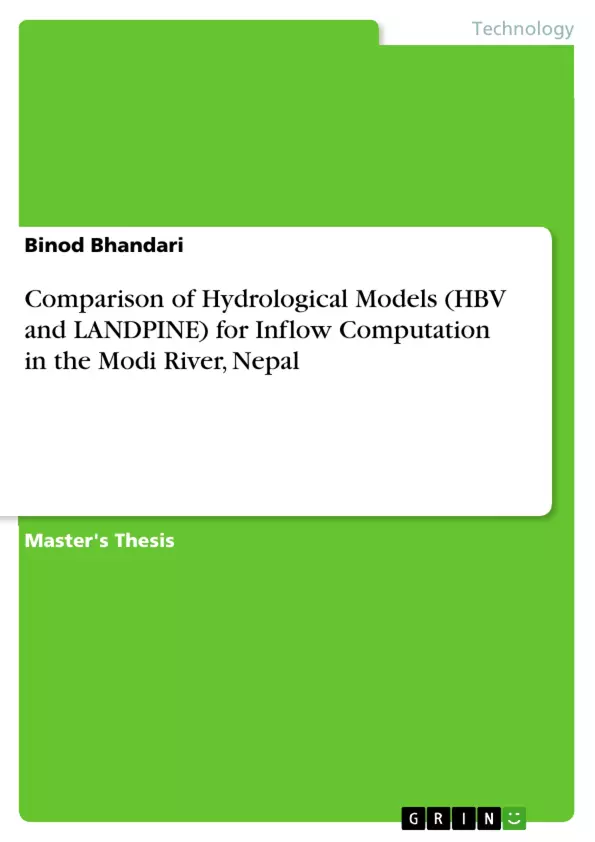A Hydrological system is a very complex process that plays a great role in controlling the water balance in the world. The hydrological cycle is a major part of the hydrological system and its components are precipitation, evaporation, snow melt, infiltration, run off, ground water movement etc. The hydrological modeling is a system concept comprising the effects of all the components involving in the hydrological cycle.
In this study, a comparison of hydrological models for inflow computation in the Modi river, a tributary of Kali Gandaki river, has been carried out by using HBV a lumped and LANDPINE a distributed model although, at first both models were developed for Scandinavian catchments. The HBV model is a conceptual precipitation run off model which is used to simulate the run off process in a catchment based on observed data of precipitation, air temperature and potential evapotranspiration. LANDPINE is a distributed hydrological rainfall runoff model to study the effects of land use changes in runoff from catchment. It operates in integration with a geological information system, usually used for preparation of input data and analysis and presentation of simulation results.
The hydro meteorological data from stations Lumle, Ghandruk and Baglung with daily discharge data at Nayapool, have been used for the study of the catchment. The two stations, Lumle and Ghandruk lie within the catchment in its southern part and the Baglung lies about 12 km outside in south west direction from the boarder of the catchment.
Available precipitation data from stations within the region are examined to determine the trend of precipitation with respect to elevation. The long term average annual precipitations for all the stations from DHM have been used. The precipitation records show that the precipitation gradient is not only dependent on the elevation and seems to be difficult to define only as a single function of the elevation. It is observed that the precipitation increases up to certain elevation and decreases thereafter.
Because of the complex nature of precipitation distributions and limited number of gauging stations, the areal precipitation distribution for this study in the case of HBV model is calculated by the combination of different weightage for different precipitation stations according to the best result obtained among them. [...]
Inhaltsverzeichnis (Table of Contents)
- INTRODUCTION
- BACKGROUND
- MOTIVATION
- OBJECTIVE OF THE STUDY
- RESEARCH METHODOLOGY
- THESIS ORGANIZATION
- DESCRIPTION OF PROJECT AREA
- LOCATION AND COVERAGE
- TOPOGRAPHY
- GEOLOGY, SOIL, VEGETATION AND LAND USE.
- HYDROMETEOROLOGY
- General Climatic Condition of Nepal.
- Meteorological Networks in Nepal
- Precipitation....
- Temperature..\li>
- Evaporation
- LITERATURE REVIEW ON HYDROLOGICAL MODELLING
- HYDROLOGICAL MODELS
- THE MODELLING PROCESS.
- CLASSIFICATION OF HYDROLOGICAL MODELS
- THE HBV MODEL
- Background and Introduction
- Properties and Applications of HBV model.
- HBV Model Structure.
- Catchment Description.
- The Soil Moisture Routine
- The Runoff Response Routine..\li>
- LANDPINE
- Introduction
- Model Description.
- Meteorological Input.
- High Vegetation
- Interception Capacity.
- Potential Evaporation
- Actual Interception and Evaporation.
- Snow
- Low Vegetation and Land Surface.
- Lake
- Root Zone/ Soil Moisture Zone.
- Surface Flow and Ground Water.
Zielsetzung und Themenschwerpunkte (Objectives and Key Themes)
This Master's thesis investigates the applicability of hydrological models for inflow computation in the Modi River, Nepal. The study aims to evaluate the performance of the HBV (lumped) and LANDPINE (distributed) models in simulating hydrological processes within a tropical catchment. The focus is on determining their ability to predict river flow, particularly during monsoon periods.
- Comparison of hydrological models (HBV and LANDPINE) for inflow computation in the Modi River, Nepal.
- Assessment of model performance in simulating hydrological processes, particularly runoff and snowmelt, within a tropical catchment.
- Analysis of the impact of precipitation variability and spatial distribution on model accuracy.
- Exploration of the applicability of models developed for Scandinavian catchments in a different geographical and climatic context.
- Evaluation of the potential for using these models for flood forecasting, water resource management, and hydropower project planning in Nepal.
Zusammenfassung der Kapitel (Chapter Summaries)
- INTRODUCTION: This chapter introduces the research topic, provides background information on hydrological modeling, and outlines the objectives and methodology of the study. It also defines the importance of accurate inflow computation for hydropower development in Nepal.
- DESCRIPTION OF PROJECT AREA: This chapter details the geographical and hydrological characteristics of the Modi River catchment, including its location, topography, geology, land use, and climate. It also discusses the available meteorological data used in the study.
- LITERATURE REVIEW ON HYDROLOGICAL MODELLING: This chapter reviews relevant literature on hydrological models, focusing on their classification, structure, and application in different contexts. It specifically describes the HBV and LANDPINE models, highlighting their key features and limitations.
Schlüsselwörter (Keywords)
Hydrological Modeling, Inflow Computation, Modi River, Nepal, HBV Model, LANDPINE Model, Precipitation, Runoff, Snowmelt, Tropical Catchment, Hydropower Development, Water Resource Management, Flood Forecasting.
- Citation du texte
- Binod Bhandari (Auteur), 2009, Comparison of Hydrological Models (HBV and LANDPINE) for Inflow Computation in the Modi River, Nepal, Munich, GRIN Verlag, https://www.grin.com/document/377543



